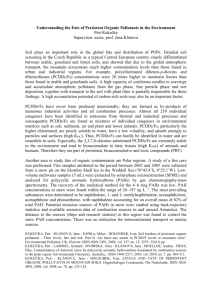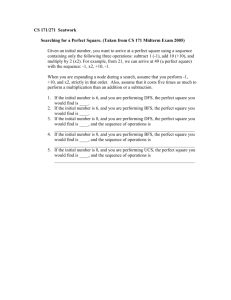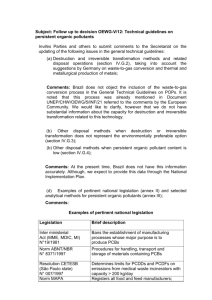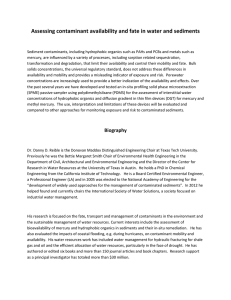Document 12070746
advertisement
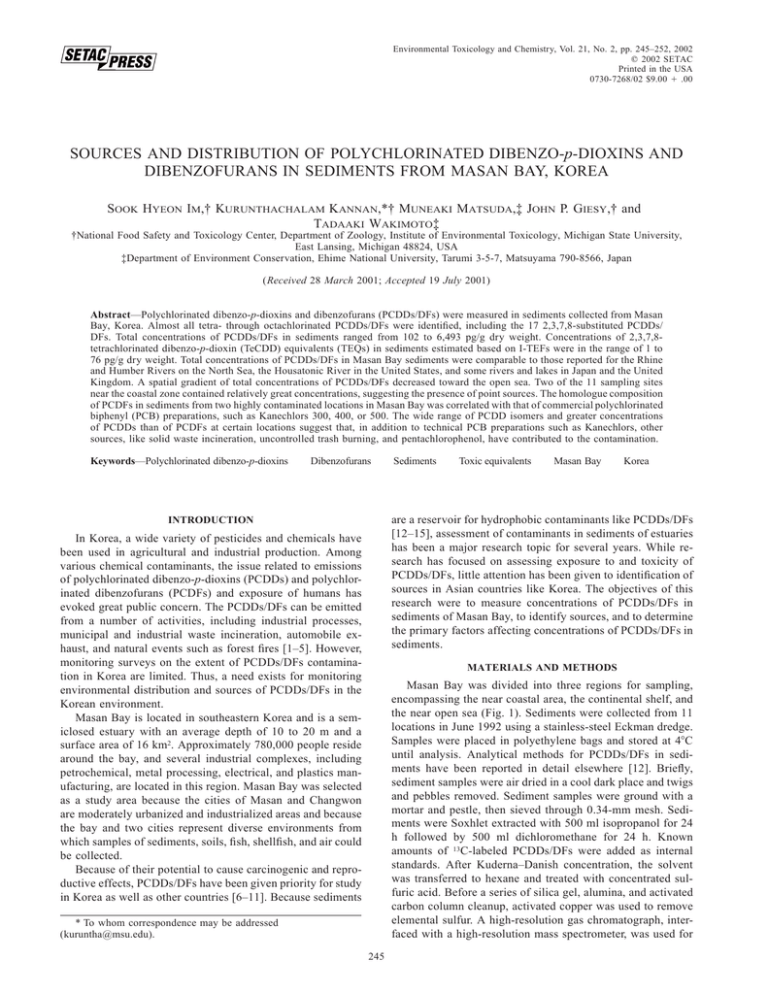
Environmental Toxicology and Chemistry, Vol. 21, No. 2, pp. 245–252, 2002 q 2002 SETAC Printed in the USA 0730-7268/02 $9.00 1 .00 SOURCES AND DISTRIBUTION OF POLYCHLORINATED DIBENZO-p-DIOXINS AND DIBENZOFURANS IN SEDIMENTS FROM MASAN BAY, KOREA SOOK HYEON IM,† KURUNTHACHALAM KANNAN,*† MUNEAKI MATSUDA,‡ JOHN P. GIESY,† and TADAAKI WAKIMOTO‡ †National Food Safety and Toxicology Center, Department of Zoology, Institute of Environmental Toxicology, Michigan State University, East Lansing, Michigan 48824, USA ‡Department of Environment Conservation, Ehime National University, Tarumi 3-5-7, Matsuyama 790-8566, Japan ( Received 28 March 2001; Accepted 19 July 2001) Abstract—Polychlorinated dibenzo-p-dioxins and dibenzofurans (PCDDs/DFs) were measured in sediments collected from Masan Bay, Korea. Almost all tetra- through octachlorinated PCDDs/DFs were identified, including the 17 2,3,7,8-substituted PCDDs/ DFs. Total concentrations of PCDDs/DFs in sediments ranged from 102 to 6,493 pg/g dry weight. Concentrations of 2,3,7,8tetrachlorinated dibenzo-p-dioxin (TeCDD) equivalents (TEQs) in sediments estimated based on I-TEFs were in the range of 1 to 76 pg/g dry weight. Total concentrations of PCDDs/DFs in Masan Bay sediments were comparable to those reported for the Rhine and Humber Rivers on the North Sea, the Housatonic River in the United States, and some rivers and lakes in Japan and the United Kingdom. A spatial gradient of total concentrations of PCDDs/DFs decreased toward the open sea. Two of the 11 sampling sites near the coastal zone contained relatively great concentrations, suggesting the presence of point sources. The homologue composition of PCDFs in sediments from two highly contaminated locations in Masan Bay was correlated with that of commercial polychlorinated biphenyl (PCB) preparations, such as Kanechlors 300, 400, or 500. The wide range of PCDD isomers and greater concentrations of PCDDs than of PCDFs at certain locations suggest that, in addition to technical PCB preparations such as Kanechlors, other sources, like solid waste incineration, uncontrolled trash burning, and pentachlorophenol, have contributed to the contamination. Keywords—Polychlorinated dibenzo-p-dioxins Dibenzofurans Sediments Toxic equivalents Masan Bay Korea are a reservoir for hydrophobic contaminants like PCDDs/DFs [12–15], assessment of contaminants in sediments of estuaries has been a major research topic for several years. While research has focused on assessing exposure to and toxicity of PCDDs/DFs, little attention has been given to identification of sources in Asian countries like Korea. The objectives of this research were to measure concentrations of PCDDs/DFs in sediments of Masan Bay, to identify sources, and to determine the primary factors affecting concentrations of PCDDs/DFs in sediments. INTRODUCTION In Korea, a wide variety of pesticides and chemicals have been used in agricultural and industrial production. Among various chemical contaminants, the issue related to emissions of polychlorinated dibenzo-p-dioxins (PCDDs) and polychlorinated dibenzofurans (PCDFs) and exposure of humans has evoked great public concern. The PCDDs/DFs can be emitted from a number of activities, including industrial processes, municipal and industrial waste incineration, automobile exhaust, and natural events such as forest fires [1–5]. However, monitoring surveys on the extent of PCDDs/DFs contamination in Korea are limited. Thus, a need exists for monitoring environmental distribution and sources of PCDDs/DFs in the Korean environment. Masan Bay is located in southeastern Korea and is a semiclosed estuary with an average depth of 10 to 20 m and a surface area of 16 km2. Approximately 780,000 people reside around the bay, and several industrial complexes, including petrochemical, metal processing, electrical, and plastics manufacturing, are located in this region. Masan Bay was selected as a study area because the cities of Masan and Changwon are moderately urbanized and industrialized areas and because the bay and two cities represent diverse environments from which samples of sediments, soils, fish, shellfish, and air could be collected. Because of their potential to cause carcinogenic and reproductive effects, PCDDs/DFs have been given priority for study in Korea as well as other countries [6–11]. Because sediments MATERIALS AND METHODS Masan Bay was divided into three regions for sampling, encompassing the near coastal area, the continental shelf, and the near open sea (Fig. 1). Sediments were collected from 11 locations in June 1992 using a stainless-steel Eckman dredge. Samples were placed in polyethylene bags and stored at 48C until analysis. Analytical methods for PCDDs/DFs in sediments have been reported in detail elsewhere [12]. Briefly, sediment samples were air dried in a cool dark place and twigs and pebbles removed. Sediment samples were ground with a mortar and pestle, then sieved through 0.34-mm mesh. Sediments were Soxhlet extracted with 500 ml isopropanol for 24 h followed by 500 ml dichloromethane for 24 h. Known amounts of 13C-labeled PCDDs/DFs were added as internal standards. After Kuderna–Danish concentration, the solvent was transferred to hexane and treated with concentrated sulfuric acid. Before a series of silica gel, alumina, and activated carbon column cleanup, activated copper was used to remove elemental sulfur. A high-resolution gas chromatograph, interfaced with a high-resolution mass spectrometer, was used for * To whom correspondence may be addressed (kuruntha@msu.edu). 245 246 Environ. Toxicol. Chem. 21, 2002 Fig. 1. Locations from which sediment samples were collected from Masan Bay, Korea. the identification and quantification of PCDDs/DFs. A Hewlett-Packard 5890 series II gas chromatograph (Avondale, PA, USA), connected to a JEOL SX102A high-resolution mass spectrometer, was employed. The capillary column was 50 m long, with a 0.25-mm i.d. and 0.2-mm stationary phase film thickness (CP-Sil 88, Chromopack, Supelco, Bellefonte, PA, USA). The temperature program was held at 708C for 1 min and then increased at a rate of 208C/min to 1808C, held for 1 min, and then increased at a rate of 28C/min to 2408C. The mass spectrometer was operated under electron impact mode at 70 eV. The PCDD/DF isomers and congeners were determined by selected ion monitoring at the two most intensive ions of the molecular ion cluster. Recoveries of 13C-labeled internal standards ranged from 78 to 86%. Reported concentrations were corrected for the recoveries of internal standard. Identification and quantification of PCDDs/DFs were performed by means of internal and external standards. A fly ash sample containing known compositions of PCDD/DF congeners was used as a reference to identify individual PCDDs/ DFs. Procedural blanks were analyzed for every five samples to check for interferences and laboratory contamination. Concentrations of PCDDs/DFs are reported as the sum of all the quantifiable isomers and congeners. Concentrations that were less than the method detection limits were assigned zero when calculating means. RESULTS AND DISCUSSION Almost all tetra- through octachlorinated PCDDs/DFs were present in all sediment samples (Table 1). Total concentrations of PCDDs/DFs and 2,3,7,8-tetrachlorodibenzo-p-dioxin equivalents in sediments ranged from 102 to 6,493 pg/g dry weight and from 1 to 76 pg/g dry weight, respectively. Although the concentrations varied considerably among the 11 sampling locations, a positive relationship was observed between concentrations of total PCDDs/DFs and concentrations of TEQs. S.H. Im et al. Measured total concentrations of PCDDs/DFs in Masan Bay sediments (102–6,493 pg/g dry wt) were comparable to or slightly less than those found in other industrialized countries. The greatest concentrations observed in sediments of the Rhine and Humber Rivers along the estuarine and coastal North Sea ranged between 1,846 and 10,557 pg/g dry weight [16]. Concentrations of PCDDs/DFs in sediments of the Housatonic River in the United States ranged from 160 to 5,400 pg/g dry weight, except in one sample that contained a concentration of 82,000 pg/g dry weight [17]. Total concentrations of PCDDs/DFs in sediments from the United Kingdom rivers ranged from 446 to 9,310 pg/g dry weight [18] and in Japan ranged from 377 to 15,792 pg/g dry weight [19]. Total concentrations of PCDDs/DFs in sediments and the spatial gradient were used to determine potential point sources in Masan Bay (Fig. 2). Concentrations of PCDDs/DFs were widely distributed even to site 11, which is near the open sea and a productive fishing area. Maximum concentrations were observed in sediments from the most industrialized sampling locations, such as sites 1 and 6, then decreased along a spatial gradient away from the coast and out to the continental shelf. These results indicate that the point sources are in the vicinity of sites 1 and 6 and reflect the importance of urban discharges as sources of PCDDs/DFs to sediments. Previously, concentrations of PCBs at or near sites 1 and 6 have been reported to be greater than the other areas of Masan Bay [13,20]. These areas are urbanized and industrialized with chemical manufacturing, electrical processes, and steel production, all of which could have contributed for PCDDs/DFs. In addition, less flushing due to geographical characteristics, such as a long, narrow inlet, results in localized sedimentation of PCDDs/DFs in Masan Bay. Different sources of PCDDs/DFs are characterized by different congener and homologue patterns [21,22]. These differences in patterns can be used to discern possible sources. Although sediments at sites 1 and 6 were high in concentrations of PCDDs/DFs, the patterns of relative concentrations were different (Table 1 and Fig. 3). The total concentration of PCDFs was sevenfold greater than that of PCDDs at site 1, while the concentration of PCDFs was only 0.65 times the total concentration of PCDDs at site 6. The homologue composition of PCDFs was similar between these two locations. Tetrachlorinated dibenzofurans (TeCDFs) contributed the greatest proportions, accounting for 58 and 42% of the total PCDFs concentrations at sites 1 and 6, respectively. The relative proportion of TeCDF was followed in decreasing order by penta (PeCDF) . hexa (HeCDF) . hepta (HpCDF) . octachlorinated dibenzofuran (OCDF). In general, 70 to ;80% of the total PCDF concentrations were attributable to lesser-chlorinated dibenzofurans, such as TeCDF and PeCDF homologues. The PCDFs occur as trace contaminants in technical PCB mixtures, and therefore the release of PCBs can be a significant source of PCDFs in the environment [23–25]. The PCDFs present in technical PCB mixtures have specific homologue patterns that are distinct from those produced during combustion. Nearly all PCDF isomers and homologues have been identified in Japanese PCB preparations such as Kanechlors 300, 400, 500, and 600 [25]. These PCB preparations did not contain detectable amounts of PCDDs. The TeCDF homologue represented 58 and 72% of the total PCDFs found in Kanechlors 300 and 400, followed in decreasing order by PeCDF, HeCDF, HpCDF, and OCDF. Both TeCDF and PeCDF homologues contributed between 80 and 93% of the total PCDFs TeCDDa 1368 1379 1378 1247 1 1248 1 1369 1268 1478 2378 1237 1234 1 1246 1 1249 1 1238 1279 1 1236 1278 1469 1239 1269 1267 1289 Total PeCDDb 12479 1 12468 12368 12478 12379 12469 1 12347 12378 12369 12467 12489 12346 12367 12389 Total HeCDDc 124679 1 124689 1 123468 123679 1 123689 123478 123678 123469 123789 123467 Total HpCDDd 1234679 1234678 Total OCDDe 12346789 Total PCDDs 4 3 0.3 2 0.4 0.1 ,0.1 ,0.1 ,0.1 ,0.1 0.1 ,0.1 9.9 5 1 ,0.1 0.5 ,0.1 0.4 ,0.1 6.9 2 ,0.1 0.1 ,0.1 ,0.1 ,0.1 ,0.1 ,0.1 ,0.1 ,0.1 ,0.1 ,0.1 2.1 7 3 ,0.1 0.4 ,0.1 0.3 ,0.1 10.7 4 3 7 8 59.1 72 31 13 15 23 7 8 13 10 ,0.1 20 6 218 57 37 7 9 5 10 2 127 33 26 59 207 820 1 66.7 2 1 3 19 7 0.9 1 0.4 ,0.1 ,0.1 6.5 10.5 0.6 ,0.1 ,0.1 ,0.1 ,0.1 ,0.1 ,0.1 45.9 3 22 8 0.3 1 ,0.1 ,0.1 ,0.1 ,0.1 ,0.1 ,0.1 ,0.1 ,0.1 ,0.1 ,0.1 ,0.1 ,0.1 31.3 2 34 16 13 35 12 6 5 14 24 19 4.5 4.5 5 9 5 3 209 1 7 87.3 6 7 13 9.6 3 1 2 0.1 1 0.3 17 5 5 0.5 3 1 0.8 0.3 0.5 0.3 ,0.1 0.3 0.3 17 18 8 0.4 2 0.6 ,0.1 0.3 1 2 1 ,0.1 ,0.1 ,0.1 ,0.1 ,0.1 ,0.1 33.3 4 5 144.2 8 8 16 19 6 1 2 0.5 1 1 30.5 10 7 1 5 2 1 0.5 1 0.1 ,0.1 0.5 0.5 28.6 44 7 2 3 1 0.3 0.3 1.5 2.5 1 0.4 0.1 0.7 0.3 ,0.1 ,0.1 64.1 5 547 1,190 115 73 188 78 38 4 7 5 3 8 143 40 32 4 ,0.1 11 4 4 2 2 ,0.1 5 5 109 110 48 6 10 3 ,0.1 1 3 6 5 2 1 3 2 3 ,0.1 203 6 Sampling location 96 383 24 27 51 35 16 1 4 1 ,0.1 5 62 22 14 1 10 4 2 1 ,0.1 ,0.1 ,0.1 3 3 60 54 30 4 8 4 ,0.1 ,0.1 4 6 4 ,0.1 ,0.1 ,0.1 ,0.1 ,0.1 ,0.1 114 7 134 179.8 4 4 8 6 2 0.3 0.6 ,0.1 0.4 0.3 9.6 4 3 0.3 2 0.6 0.4 0.1 0.2 0.2 ,0.1 0.3 0.2 11.3 8 4 0.6 1 0.5 ,0.1 ,0.1 0.5 1.3 0.7 ,0.1 0.3 ,0.1 ,0.1 ,0.1 ,0.1 16.9 8 81 205.5 29 20 49 16 7 1 2 0.5 1 0.3 27.8 8 4 0.7 3 2 0.5 ,0.1 0.9 ,0.1 ,0.1 0.7 0.3 20.1 13 7 1 2 0.6 ,0.1 ,0.1 1 1.4 0.7 ,0.1 0.6 ,0.1 0.3 ,0.1 ,0.1 27.6 9 Table 1. Polychlorinated dibenzo-p-dioxins and dibenzofurans (PCDDs/DFs) concentrations (pg/g, dry wt) of sediments from Masan Bay, Korea 23 135.8 20 15 35 20 6 ,0.1 2 ,0.1 2 0.7 30.7 7 6 0.7 4 1 0.5 0.3 0.4 0.4 ,0.1 0.5 0.3 21.1 15 7 ,0.1 3 ,0.1 ,0.1 ,0.1 0.1 0.1 0.8 ,0.1 ,0.1 ,0.1 ,0.1 ,0.1 ,0.1 26 10 46 93.9 6 4 10 7 3 0.3 0.7 ,0.1 0.5 ,0.1 11.5 4 3 0.2 2 0.6 0.3 ,0.1 0.2 0.1 ,0.1 0.2 0.2 10.8 9 4 0.5 0.9 0.3 ,0.1 ,0.1 0.1 0.1 0.5 ,0.1 0.2 ,0.1 ,0.1 ,0.1 ,0.1 15.6 11 Dioxins in Korean sediments Environ. Toxicol. Chem. 21, 2002 247 TeCDFf 1368 1378 1 1379 1347 1468 1247 1 1367 1348 1346 1248 1246 1 1268 1237 1 13691 1478 1234 1 1678 1238 1 1467 1 1236 2468 1349 1278 1267 1 1279 1469 1249 2368 2467 1239 2347 1269 2378 2348 2346 2367 3467 1289 Total PeCDFg 13468 12468 13678 13479 13478 1 12368 12478 12479 1 13467 12467 12347 14678 13469 12348 1 12378 12346 12379 12367 12469 1 12678 12679 12369 23468 0.7 0.7 0.3 0.4 0.9 0.4 0.3 0.3 0.5 1.5 0.4 1 2 0.1 0.6 0.4 0.2 0.4 0.2 0.4 0.2 0.1 0.1 0.4 0.3 0.3 0.4 0.3 ,0.1 13.8 0.5 0.8 0.5 0.5 0.7 0.6 0.5 0.3 0.3 0.3 0.2 0.6 0.2 0.2 0.3 0.5 0.2 0.2 0.2 77 82 46 55 70 65 106 99 63 63 19 69 40 40 48 79 30 7 40 2 102 84 102 127 212 91 118 118 180 258 203 300 60 23 91 135 110 21 10 181 70 53 10 37 116 175 155 115 12 3,269 1 0.8 1 0.6 1 1.2 2 0.8 0.8 0.5 0.5 0.2 2 0.3 0.3 0.5 0.9 0.3 ,0.1 0.9 0.9 1 0.6 0.7 1 0.4 0.5 0.5 0.6 0.8 1 1 2 1 1.9 0.6 0.4 0.6 0.3 0.6 0.5 0.4 0.5 0.7 1 0.5 0.1 ,0.1 ,0.1 20.1 4 3 3 2 2.5 3.5 3 3 3 2 2 0.3 4 1.5 1.5 2 3 0.4 0.5 3 3 4 2 2 5 2 2 2 0.4 4 3 4 3 0.4 3 3 1 2 1 4 2 5.4 0.3 0.7 3 2 3 2 0.2 69.4 5 9 10 6 11 14 17 13 18 6 11 8 2 5 5 8 5 6 1 13 10 17 10 10 22 8 8.5 8.5 12 30 11 20 18 3 18 25 20 3 15 11 5 4 3 6 8 5 10 4 5 330 6 4 6 2 5 4 9 2 4 1.5 1.5 0.7 2 0.5 0.5 2 4 2 ,0.1 4 ,0.1 4 ,0.1 ,0.1 4 2 2 2 2 2 ,0.1 5 6 ,0.1 6 3 1 2 1 3 5 2 ,0.1 3 5 2 3 ,0.1 ,0.1 65 7 0.4 0.6 0.3 0.5 0.6 1 0.4 0.5 0.3 0.3 0.1 0.6 0.2 0.2 0.3 0.5 0.2 0.1 0.3 0.4 0.7 0.4 0.4 0.7 0.3 0.4 0.3 1 1 0.4 1 1 ,0.1 0.8 0.5 0.2 0.3 0.1 0.6 0.1 0.2 ,0.1 6 3 0.3 0.7 0.4 ,0.1 21.2 8 2 4 1 1.5 1.8 3 2 2 1 1 0.5 3 0.5 0.5 1 1.3 1 0.3 1 1 2 0.9 0.9 2 0.7 1 1 1 0.5 2 2 2 0.1 2 2 0.5 0.5 0.3 2 0.5 0.1 0.1 1.9 0.7 1.5 2 0.7 ,0.1 31.9 9 1 2 0.8 1 1.2 2 1 1 1 1 0.2 2 0.5 0.5 0.8 ,0.1 0.1 0.9 1 0.6 0.9 0.4 0.4 1 0.4 0.5 0.5 1 1 0.9 1 1 0.1 1 0.7 0.2 0.4 0.2 0.9 0.2 1 ,0.1 0.7 0.4 0.4 0.9 0.4 ,0.1 17.1 10 0.4 0.9 0.3 0.5 0.1 1 0.4 0.4 0.3 0.3 0.1 1 0.1 0.1 0.2 0.3 0.7 0.1 0.3 0.4 0.6 0.3 0.3 0.6 0.2 0.3 0.2 0.5 0.3 0.3 0.3 0.7 0.1 0.3 0.4 0.3 0.1 0.1 0.4 0.1 0.2 0.3 0.4 0.1 0.2 0.3 0.2 ,0.1 8.5 11 Environ. Toxicol. Chem. 21, 2002 0.6 11 0.5 0.5 0.7 1 0.6 0.6 0.3 0.3 0.2 1 0.3 0.3 ,0.1 0.3 1.2 0.2 0.3 1 0.9 0.4 0.6 1 0.4 0.5 0.4 0.5 1.5 0.7 1 2 0.9 ,0.1 0.6 0.3 0.4 0.2 1 0.2 0.2 ,0.1 0.4 0.4 0.4 0.5 0.4 ,0.1 16.8 3 Sampling location Table 1. Continued 248 S.H. Im et al. 0.9 0.6 2 ,0.1 0.6 0.6 ,0.1 1 ,0.1 0.3 0.3 ,0.1 0.3 6.6 7 ,0.1 7 ,0.1 14 ,0.1 59 43 102 0.7 1 85 132 122 16 62 59 6 123 5 16 10 5 66 707 300 56 16 ,0.1 372 ,0.1 820 5,673 6,493 6.9 76 b a ,0.1 67 56 123 0.8 1 2 ,0.1 ,0.1 ,0.1 2 2 3 4 0.5 2 2 0.5 1 ,0.1 0.3 ,0.1 ,0.1 0.9 16.2 0.2 ,0.1 0.5 ,0.1 0.6 21.2 ,0.1 0.2 0.3 ,0.1 0.2 8.3 7 5 70 2 143 1,325 TeCDD 5 tetrachlorodibenzo-p-dioxin. PeCDD 5 pentachlorodibenzo-p-dioxin. c HeCDD 5 hexachlorodibenzo-p-dioxin. d HpCDD 5 heptachlorodibenzo-p-dioxin. e OCDD 5 octachlorodibenzo-p-dioxin. f TeCDF 5 tetrachlorodibenzofuran. g PeCDF 5 pentachlorodibenzofuran. h HeCDF 5 hexachlorodibenzofuran. i HpCDF 5 heptachlorodibenzofuran. j OCDF 5 octachlorodibenzofuran. k TEQs 5 toxic equivalency quotients. 12349 12489 23478 12389 23467 Total HeCDFh 123468 1346878 1 134679 124678 124679 123478 1 123479 123678 124689 123467 123679 123469 1 123689 123789 123489 234678 Total HpCDFi 1234678 1345679 1234689 1234789 Total OCDFj 12346789 Total PCDDs Total PCDFs Total PCDDs 1 PCDFs Quotient PCDFs/PCDDs TEQsk 3 2 1 ,0.1 87 85 172 1 4 9 0.3 0.9 0.3 10.5 3 4 7 0.8 9 6 0.8 3 0.5 0.6 0.6 0.5 2 37.8 0.2 0.2 0.9 ,0.1 0.5 16.4 4 ,0.1 144 211 355 1.5 5 19 5 3 ,0.1 27 9 11 11 1 10 11 1 2 0.8 1 1 0.6 5 64.4 0.3 0.3 2 0.2 3.7 49.7 5 12 1,190 782 1,972 0.7 21 48 2 1 1 52 23 27 31 4 14 10 ,0.1 37 12 4 6 2 13 183 2 2 20 ,0.1 13 205 6 Sampling location Table 1. Continued 30 383 284 667 0.7 9 36 12 ,0.1 ,0.1 48 6 9 15 1 19 11 ,0.1 7 ,0.1 1 5 ,0.1 4 78 ,0.1 ,0.1 4 ,0.1 4 62.7 7 ,0.1 180 45 225 0.3 2 3 0.2 0.5 ,0.1 3.7 0.9 1 2 0.2 3 2 0.4 0.8 ,0.1 0.2 ,0.1 ,0.1 0.7 11.2 ,0.1 ,0.1 0.7 ,0.1 0.5 8.6 8 ,0.1 206 152 358 0.7 3 42 ,0.1 17 ,0.1 59 4 3 8 0.5 4 2 2 2 ,0.1 0.5 2 0.2 1 29.2 0.2 ,0.1 0.9 ,0.1 2 31.5 9 ,0.1 136 97 233 0.7 2 33 2 7 ,0.1 42 2 3 4 0.3 3 2 0.5 1 ,0.1 0.5 ,0.1 0.2 0.6 17.1 ,0.1 0.2 0.9 0.5 1 20.6 10 ,0.1 95 51 146 0.5 1 13 ,0.1 5 ,0.1 18 0.8 9 2 0.2 2 1 0.4 0.5 ,0.1 0.2 0.2 0.2 ,0.1 16.5 0.1 0.1 0.2 ,0.1 0.4 8.3 11 Dioxins in Korean sediments Environ. Toxicol. Chem. 21, 2002 249 250 Environ. Toxicol. Chem. 21, 2002 S.H. Im et al. Fig. 2. Total concentrations of polychlorinated dibenzo-p-dioxins and dibenzofurans (PCDDs/DFs) (pg/g dry wt) at each sampling location in sediments collected from Masan Bay, Korea. in Kanechlors 300 and 400. Greater proportions of TeCDF and PeCDF homologues in sediments at sites 1 and 6 correspond well with those reported for Kanechlors 300 and 400. Furthermore, significant linear correlations existed between PCDF homologue compositions in sediments at sites 1 and 6 and the Kanechlor preparations (Figs. 4 to 6). The composition of PCDFs in sediments from site 1 was as follows: TeCDF (57.6%), PeCDF (23.4%), HeCDF (12.5%), HpCDF (6.6%), and OCDF (0%). For Kanechlor 300, the homologue composition of PCDFs is as follows: TeCDF (58.2%), PeCDF (21.4%), HeCDF (14.2%), HpCDF (4%), and OCDF (2.3%). A significant correlation was observed between sediment and Kanechlor 300 profiles of PCDFs (Fig. 4; r 5 0.99). Similar to that for Kanechlor 300, a significant correlation (r 5 0.99) existed between the PCDFs homologue distribution at site 1 sediments and Kanechlor 400 (Fig. 5). The proportion of PCDF homologues in Kanechlor 400 is TeCDF (72.3%), PeCDF (20.9%), HeCDF (5.1%), HpCDF (1.05%), and OCDF (0.77%), respectively. No significant correlation was observed between profiles of PCDFs in sediments from site 1 and those in Kanechlors 500 or 600. Similarly, when relative concentrations of individual isomers from each homologue group of PCDFs in sediments were compared with those in Kanechlors, Fig. 3. Concentrations (pg/g dry wt) of polychlorinated dibenzo-pdioxins and dibenzofurans (PCDDs/DFs) homologues at each sampling location. Both site 1 and site 6 are near probable point sources of PCDDs/DFs contamination. Distinctive inputs of PCDFs relative to PCDDs were observed at site 1. Fig. 4. Correlation of relative proportion of polychlorinated dibenzofurans (PCDFs) homologues at site 1 of this study (x-axis) with Kanechlor (KC) 300 preparation given by Wakimoto et al. [25] (yaxis). Each homologue is expressed as the percentage of total PCDFs. few isomers were less in sediments than that in Kanechlors 300 and 400. This could be due to selective degradation of certain PCDF congeners in sediments. Despite this, the results suggest that technical PCB mixtures may be one of the possible sources of PCDFs in sediments at site 1. Concentrations of PCBs in sediment near sites 1 and 6 were in the range of 150 to 200 ng/g dry weight [12,13,20]. Although concentrations of PCDDs were greater than those of PCDFs at site 6, the PCDFs homologue pattern in sediments from site 6 was correlated with those in Kanechlor 300 (r 5 0.93) (Fig. 6), 400 (r 5 0.87), and 500 (r 5 0.66). The greater concentrations of PCDFs than of PCDDs and the correlation of the PCDF homologue pattern in sediments with technical PCBs suggest sources originating from technical PCB preparations. Furthermore, the presence of a series of PCDD isomers at both Fig. 5. Correlation of relative proportion of polychlorinated dibenzofurans (PCDFs) homologues at site 1 of this study (x-axis) with Kanechlor (KC) 400 preparation given by Wakimoto et al. [25] (yaxis). Each homologue is expressed as the percentage of total PCDFs. Environ. Toxicol. Chem. 21, 2002 Dioxins in Korean sediments 5. 6. 7. 8. 9. Fig. 6. Correlation of relative proportion of polychlorinated dibenzofurans (PCDFs) homologues at site 6 of this study (x-axis) with Kanechlor (KC) 300 preparation given by Wakimoto et al. [25] (yaxis). Each homologue is expressed as the percentage of total PCDFs. 10. 11. site 1 and site 6 suggest the occurrence of other sources as well. Among possible sources of PCDDs, thermal processes, such as municipal and chemical waste incineration (including uncontrolled trash burning), hospital waste incineration, and other combustion processes, can result in the production of a range of PCDD isomers [26–28]. Pentachlorophenol production also results in significant releases of OCDD [29]. A wide range of tetra- through octachlorinated PCDD isomers were identified in all samples from Masan Bay, and great concentrations of OCDD at certain locations, including site 6, were present. This suggests sources originating from incineration and possibly from the use of pentachlorophenol. Only 4% of the municipal and industrial waste are incinerated in Korea, while in other industrialized countries up to 74% of the waste is treated [30]. No incinerators exist nearby Masan Bay, but uncontrolled open burning of industrial wastes has been identified in the vicinity of this bay. These incineration activities are currently a major source of PCDDs. In summary, concentrations of PCDDs/DFs in sediments from Masan Bay are comparable to those in sediments in other industrialized countries. At least two point sources of PCDDs/ DFs have been identified in the industrial zone of Masan Bay. The PCDDs/DFs homologue profile in certain highly contaminated locations suggested a source originating from commercial PCB preparations. In addition, uncontrolled incineration of industrial wastes in open areas and the usage of pentachlorophenol have contributed for the PCDDs/DFs sources in Masan Bay. 12. 13. 14. 15. 16. 17. 18. 19. 20. 21. 1. 2. 3. 4. REFERENCES Macdonald RW, Ikonomou MG, Paton DW. 1998. Historical inputs of PCDDs, PCDFs, and PCBs to a British Columbia interior lake: The effect of environmental controls on pulp mill emissions. Environ Sci Technol 32:331–337. Lemieux PM, Lutes CC, Abbott JA, Aldous KM. 2000. Emissions of polychlorinated dibenzo-p-dioxins and polychlorinated dibenzofurans from the open burning of household waste in barrels. Environ Sci Technol 34:377–384. Vikelsøe J, Johansen E. 2000. Estimation of dioxin emission from fires in chemicals. Chemosphere 40:165–175. Ballschmitter K, Buchert H, Niemczyk R, Munder A, Swerev M. 22. 23. 24. 251 1986. Automobile exhaust versus municipal-waste incineration as sources of the polychlorinated dibenzo-p-dioxins and -furans found in the environment. Chemosphere 15:901–915. Stanmore BR, Ross CC. 2000. An empirical model for the de novo formation of PCDD/F in medical waste incinerators. Environ Sci Technol 34:4538–4544. Kociba RJ, et al. 1978. Results of a two-year chronic toxicity and oncogenicity study of 2,3,7,8-tetrachlorodibenzo-p-dioxin in rats. Toxicol Appl Pharmacol 46:279–303. Murray FJ, Smith FA, Nitschke KD, Humiston CG, Kociba RJ, Schwetz BA. 1979. Three generation reproduction study of rats given 2,3,7,8-tetrachlorodibenzo-p-dioxin (TCDD) in the diet. Toxicol Appl Pharmacol 50:241–252. Peterson R, Theobald H, Kimmel G. 1993. Developmental and reproductive toxicity of dioxins and related compounds: Cross species comparisons. Crit Rev Toxicol 23:283–335. Kannan K, Ueda M, Shelby A, Mendonca MT, Kawano M, Matsuda M, Wakimoto T, Giesy JP. 2000. Polychlorinated dibenzop-dioxins (PCDDs), dibenzofurans (PCDFs), biphenyls (PCBs), and organochlorine pesticides in yellow-blotched map turtle from the Pascagoula River basin, Mississippi, USA. Arch Environ Contam Toxicol 38:362–370. Brzuzy LP, Hites RA. 1996. Global mass balance for polychlorinated dibenzo-p-dioxins and dibenzofurans. Environ Sci Technol 30:1797–1804. Im SH, Min BY, Matsuda M, Wakimoto T. 1995. Levels of polychlorinated dibenzo-p-dioxins and dibenzofurans in surface sediments at and surface soils around Masan Bay in Korea. J Environ Chem 5:625–636. Im SH. 1996. Dynamic variations of PCDDs/DFs, PCBs and DDT in selected aquatic and terrestrial media from Masan Bay (Korea), and from its environs. PhD thesis. Ehime University, Matsuyama City, Japan. Im SH, Matsuda M, Wakimoto T, Min BY. 1994. Distribution of polychlorinated biphenyls (PCBs) in sediments from Masan Bay, Korea. J Environ Chem 4:851–855. Fattore E, Benfenati E, Mariani G, Fanelli R. 1997. Patterns and sources of polychlorinated dibenzo-p-dioxins and dibenzofurans in sediments from the Venice Lagoon, Italy. Environ Sci Technol 31:1777–1784. Bright DA, Cretney WJ, Macdonald RW, Ikonomou MG, Grundy SL. 1999. Differentiation of polychlorinated dibenzo-p-dioxin and dibenzofuran sources in coastal British Columbia, Canada. Environ Toxicol Chem 18:1097–1108. Evers EHG, Klamer HJC, Laane RWPM, Govers HAJ. 1993. Polychlorinated dibenzo-p-dioxin and dibenzofuran residues in estuarine and coastal North Sea sediments: Sources and distribution. Environ Toxicol Chem 12:1583–1598. Eitzer BD. 1993. Comparison of point and nonpoint sources of polychlorinated dibenzo-p-dioxins and polychlorinated dibenzofurans to sediments of the Housatonic River. Environ Sci Technol 27:1632–1637. Rose CL, McKay WA, Ambidge PF. 1994. PCDD and PCDF levels in river systems in England and Wales, UK. Chemosphere 29:1279–1292. Sakurai T, Kim JG, Suzuki N, Nakanishi J. 1996. Polychlorinated dibenzo-p-dioxins and dibenzofurans in sediment, soil, fish and shrimp from a Japanese freshwater lake area. Chemosphere 33: 2007–2020. Khim JS, Kannan K, Villeneuve DL, Koh CH, Giesy JP. 1999. Characterization and distribution of trace organic contaminants in sediment from Masan Bay, Korea. 1. Instrumental analysis. Environ Sci Technol 33:4199–4205. Alcock RE, Jones KC. 1996. Dioxins in the environment: A review of trend data. Environ Sci Technol 30:3133–3143. Wenning RJ, Harris MA, Finley B, Paustenbach DJ, Bedbury H. 1993. Application of pattern recognition techniques to evaluate polychlorinated dibenzo-p-dioxin and dibenzofuran distributions in surface sediments from the lower Passaic River and Newark Bay. Ecotoxicol Environ Saf 25:103–125. Erickson MD, Swanson SE, Flora JD Jr, Hinshaw GD. 1989. Polychlorinated dibenzofurans and other thermal combustion products from dielectric fluids containing polychlorinated biphenyls. Environ Sci Technol 23:462–470. Norwood CB, Hackett M, Pruell RJ, Butterworth BC, Williamson KJ, Naumann SM. 1989. Polychlorinated dibenzo-p-dioxins and 252 Environ. Toxicol. Chem. 21, 2002 dibenzofurans in selected estuarine sediments. Chemosphere 18: 553–560. 25. Wakimoto T, Kannan N, Ono M, Tatsukawa R, Masuda Y. 1988. Isomer-specific determination of polychlorinated dibenzofurans in Japanese and American polychlorinated biphenyls. Chemosphere 17:743–750. 26. Yasuhara A, Ito H, Morita M. 1987. Isomer-specefic determination of polychlorinated dibenzo-p-dioxins and dibenzofurans in incinerator-related environmental samples. Environ Sci Technol 21:971–979. S.H. Im et al. 27. Sakai S, Yamane H, Takatsuki H, Aoki I. 2000. Emission factor of PCDD/DF from the combustion of chlorine containing materials. Organohalogen Compounds 45:340–343. 28. Wijnen JHV, Liem AKD, Olie K, Zorge JAV. 1992. Soil contamination with PCDDs and PCDFs of small (illegal) scrap wire and scrap car incineration sites. Chemosphere 24:127–134. 29. Wittsiepe J, Kullmann Y, Schrey P, Selenka F, Wilhelm M. 2000. Myeloperoxidase-catalyzed formation of PCDD/F from chlorophenols. Chemosphere 40:963–968. 30. Ishikawa Y. 1995. The Waste Treatment and Global Environment in the Future. Chuouhoukyu, Tokyo, Japan (in Japanese).

